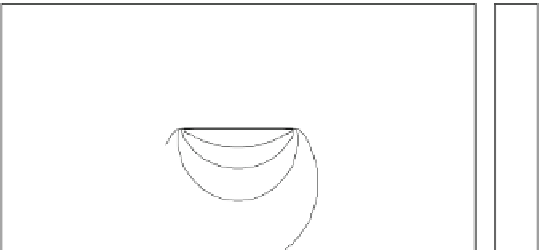Environmental Engineering Reference
In-Depth Information
100
80
5.65
60
5.6
40
5.55
20
0
5.5
-20
5.45
-40
-60
5.4
-80
5.35
-100
0
50
100
150
200
250
300
350
400
Fig. 15.3 Doublette system (iso potential and streamlines)
symmetry line, which is an isopotential line, is perpendicular to the connecting line.
Note that the depicted is potentials are not completely identical on the left and right
side of the figure, which stems from the fact that the internally determined potential
levels are not symmetrical around the mean value. It is also easy to see that all
streamlines and is potentials are circles. If that is not true on the user's computer
display, it probably depends on the scaling that may not be the same for both length
axes. Moreover, streamlines and is potentials meet at right angles. All these
properties are well known from classical theory, but it is nice to see them confirmed
using a small M-file.
15.2.2 Mirror Wells
The modeller may utilize non-existing wells in order to simulate special boundary
conditions. For that purpose
virtual wells
are introduced that do not exist in reality.
The previous example showed the simple doublette system with a constant potential
line as a symmetry axis between both wells. The modeller may thus take advantage
of that property and use such a doublette system to produce a constant potential
boundary where it is needed. In fact, for each real well a virtual well needs to be
located at the mirror position with respect to the is-potential line. For real pumping
wells the
mirror well
should be a recharge well and vice versa.
A typical application is given for a well or a well gallery in the vicinity of a river
or lake. The spatial gradient within the surface water body is usually very small and
can be neglected. If both water bodies, groundwater and surface water, are well
connected, the shoreline becomes a constant head boundary for the groundwater
modeller. Constant head corresponds with constant potential. The formula for the
analytical solution of such a situation is identical to the doublette solution. How-
ever, in this case the pattern needs to be computed only for that side of the bank
where ground surface and well are located. The 'virtual side' should be omitted.















































































